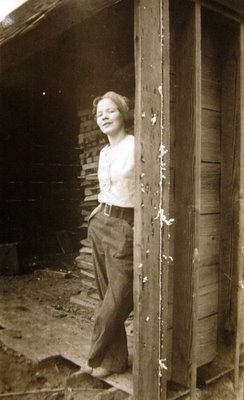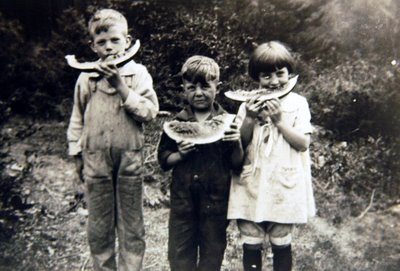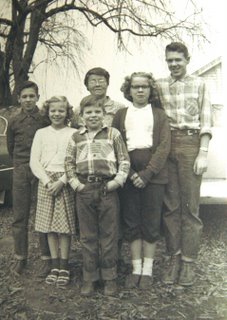Christian Bang Smith: An account about my life
(see Leah's family tab for family history)
I was born in Fausing in Jutland on the third of April, 1842; christened on the 29th of May the same year and confirmed in 1856; son of schoolteacher Christen Schmidt and Christiane Cicilie (born Bang)
On the second of April 1856 I left my home and went to my uncle, Niels Bang, at Marienborg, in order to learn to farm-bailiff {ed note: a farm manager or overseer}. On the 23rd of April 1859 I left this farm and came then to Raaballegaard in order to educate me further in the practice of farming.
On the 11th of January 1862 I left Raaballegaard to go home to my father in order to manage his farm. I remained home two years and after that went to the agricultural college in Nimtofte and was there a half-year.
On the first of May 1865 I came to Constantigaard in order to be farm-bailiff at this farm. I was farm-bailiff there until the 21st of April 1866 and went from there because I had decided to go to America.
------------
On the 29th of April 1866 I left my home and native town and began my long journey. I went then to Randers and left by steamship to Copenhagen. I stayed in Copenhagen until the 18th of May then went by railway train to Korsor, then the next day by steamship to Kiel and by railway train to Hamburg.
On the 19th of May in the evening we came on board the steamship Teutonia and on the 20th of May, Whitsunday morning {ed note: religious holiday observed seven weeks after Easter} at three o'clock there we weighed anchor and began to sail.
The first day we had very beautiful weather; in the morning we had black coffee and smorrebrod (a specialty with no English word, slices of bread and butter covered in meat, cheese etc...) and for dinner we had consomme made of beef.
The 21st was beautiful weather the whole day, for dinner peas and fresh beef and potatoes. In the afternoon we began to see Scotland. The 22th was beautiful weather but began to be rather much windy; in the morning we passed by northern Scotland. I began to be seasick in the afternoon; for dinner peas and beef but so salty that it was unbearable to eat - herring we had, too, but they were equally too salty and we threw them out in the ocean.
The 23rd was rather too much windy the whole day; for dinner boiled beans in white sauce and pork but they, too, had too much salt. Been seasick and in bed most of the day. The 24th very windy the whole day, been very sick and nothing eaten; for dinner sodsuppe (an old Danish specialty, a kind of soup made with sago with fruit, syrup etc...) and pudding.
Been in bed most of the day. The 25th beautiful weather but very windy, for dinner soup and fresh beef but haven't eaten for most of the day. I have been very sick. The 26th very fogged but the ocean more quiet.
Today I have become to become more healthy and eaten rather good, for dinner peas and pork.
This morning a woman was confined down beside us. The 27th, Sunday, windy rainy weather and contrary wind; for dinner peas and beef. Slaughtered an ox and two sheeps. The 28th forgot to write. The 29th today, rainy weather and very windy; for dinner peas, potatoes and meat.
A woman died here on the ship.
On the 30th rainy weather and a high wind; for dinner peas and pork. A woman was confined; been in bed most of the day. The 31st beautiful weather with a little contrary wind; for dinner sodsuppe and meat. The first of June very beautiful weather; for dinner soup, beef and potoatoes. Today seen many sailing ships.
A Swedish child died.
The second of June very beautiful weather. For dinner peas and fresh beef. the American pilot came on board at 3 o'clock, in afternoon began to land. Reached New York at 6 o'clock the third of June. Was at anchor in the port of New York in the night. For dinner sodsuppe and German clots (??). The 4th gone from New York and reached Waupaca {ed note: Wisconsin) the 12th of June 1866.
-----------------------------------
Hired of Luther West the 21st of June and remained there until the 25th of November. The 26th of November moved to shoemaker Larson and served there for 12 dollars a month until 12th of December. The 12 of December hired of Leonard Arnold for 18 dollars a month and remained there until the 14th of March 1867.
Been sick from the 14th of March to the 19th of November and for this time stayed for four months by Swedish Larsons and five months by Chr. Johnsons. The 19th of October hired of Mrs. Stratton and remained there until the 24th of February 1868. The 24th of February moved over to Sidse Anders in order to get the food there. The ninth of March hired to clerk for Richard Lea for 30 dollars a month.
--------------------------------
{ed note: at this time Christian was 24 years old}
On the 25th of July 1868 I bought Hans Larson's house for $575. On the first of December 1868 I married Marie Karen Petersen, daughter of blacksmith Peter Jensen Schou and Mette Kisstine, born Hansen. Their native soil was in the town of Norre Vestud at Mon (a small island southeast of Sjaelland in Denmark, but in the year 1862 they went over to America and bought a farm, which is situated one mile west of Rural (?? illegible).
My wife was born on the first of December 1849 and was little more than 13 years old when she came here to the country. She was confirmed here in Waupaca and when she was 19 years we married. On the eighth of October 1869 my wife gave birth to our little son Christen Vilhelm Smith, a Friday, and on the third of January he was christened. On the 29th of January 1872, a Tuesday, was our little son Peter Oscar Smith born and on the 26th of March he was christened On the 28th of March 1874, a Satuday, was our little daughter Christiane Cecilie Smith born.
On the the 15th of July 1872 I exchanged my house for a farm in the town of Lind (??) and gave $350 dollars in exchange. On the eighth of March 1876, a Wednesday, was our little daughter Clara Nathalie Smith was born.
On the eighth of September 1878, a Sunday, was our little son Carl Frederik Smith born.
On the ninth of November 1878 died my dear wife died
On the 18th of June 1881 I married to Christine Jensen. On the 26th of April 1882 Marie was born, on a Wednesday. On the fifth of December, 1884, Ane was born, a Friday.
-------------------
{notes about Smith side, by Christian}
Mother born November 28 1807, died February 1861
Father born December 28 1811, died April 3, 1882
Sister Christine Thora Smith born January 16, 1839, died May 11 1891
Brother Rasmus Smith born September 20, 1840
Sister Marie Nicoline Smith born Dec. 22, 1843, died Feb. 22, 1879
Sister Clara Nathalie Smith born Oct 23, 1847, died Sept. 26, 1872
{note added, difficult to read but Grenaa is a town on North Sea, the east coast of Denmark}
"Brother's address:
Hr R Schmidt
Baadsdal
Qrum pr Grenaa
Jylland
Denmark, Europa"
--------------
[note about Jensen side, unknown author]
Grandmother Jensina Katrina Jensen born 1825 on Ris or Riis Hanregaard (Sp?), two miles (illegible) her father died when she was 7, mother when 15. One of 12 children. Mother foolish about another man and sold her estate to him for hundreds of dollars where it worth thousands. She reserved a widow's interest, or allowance, in it, but that ended with her death. The man did not marry her. After her death the daughters each received about 800 apiece, the sons twice that.
Grandmother Jamfort, Jensine Katrine Jensen
Grandfather Jens Madson Bohle
(first cousin to grandma and seven years younger)
{notes by Aunt Maren on Jensen side of family, about her parents etc...};
Your mother's name: Jensine Katrine Jensen, born 1825, in Vork, Denmark; died 1890.
Your father's name: Jens Madsen; born 1830 in Vork, Denmark; died 1870 in Vork.
Tante Karen born 1855 in Vork, died Jan. 1, 1926
Christine (Marie Smith's mother) born 1857, Vork Denmark; died 1892.
Mads, born in Vork, Denmark 1860, died Manistee, Wisconsin, 1940
Maren born 1863 in Vork Denmark; Maren Ryensine Hielsen











